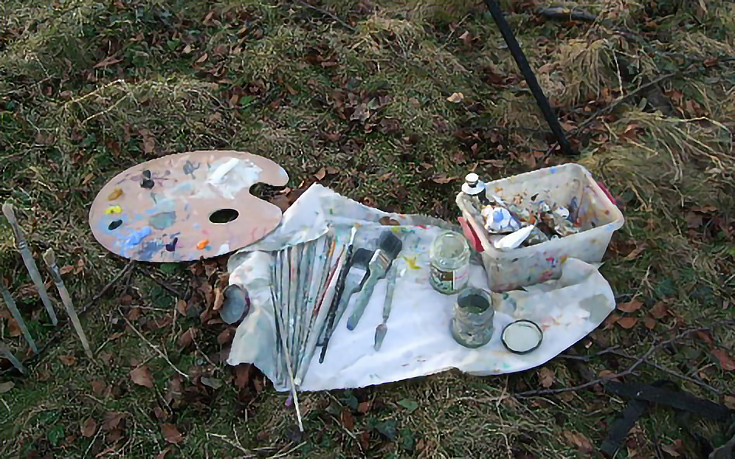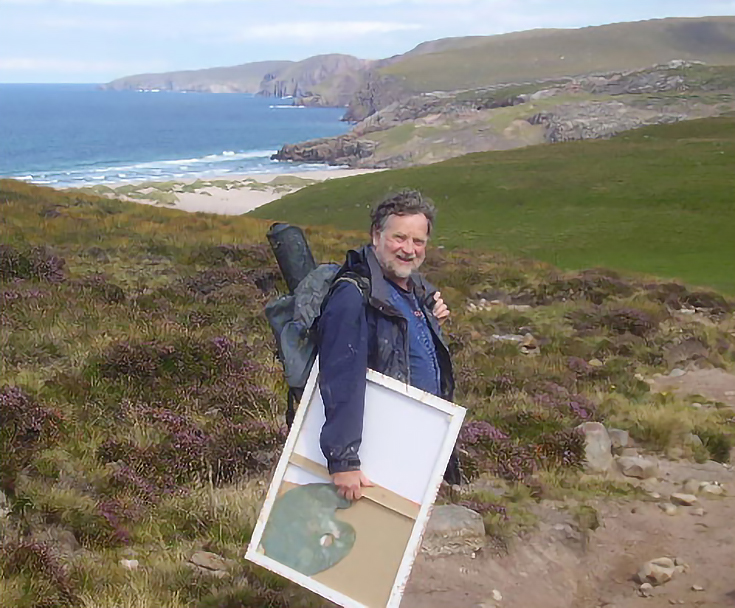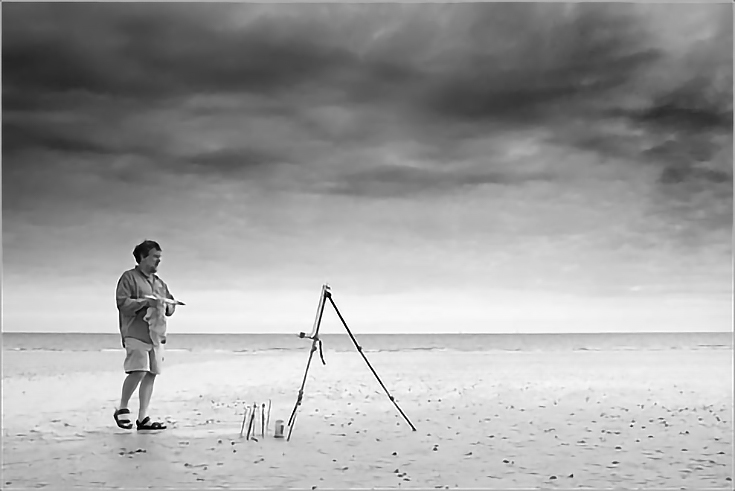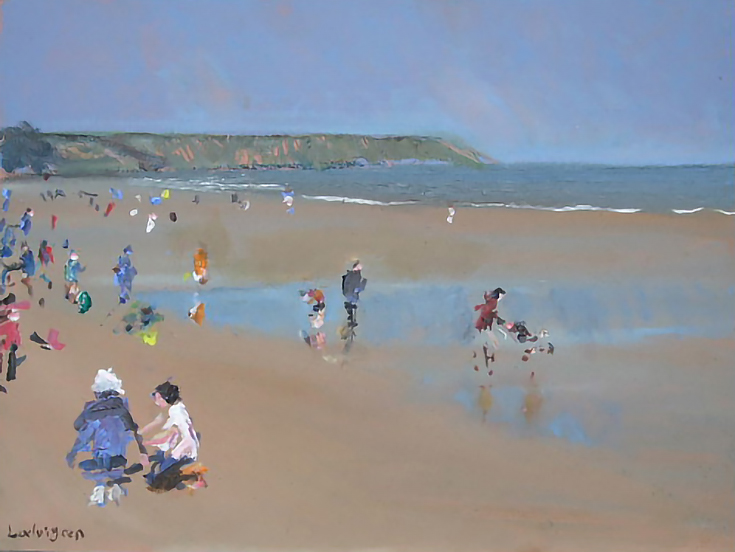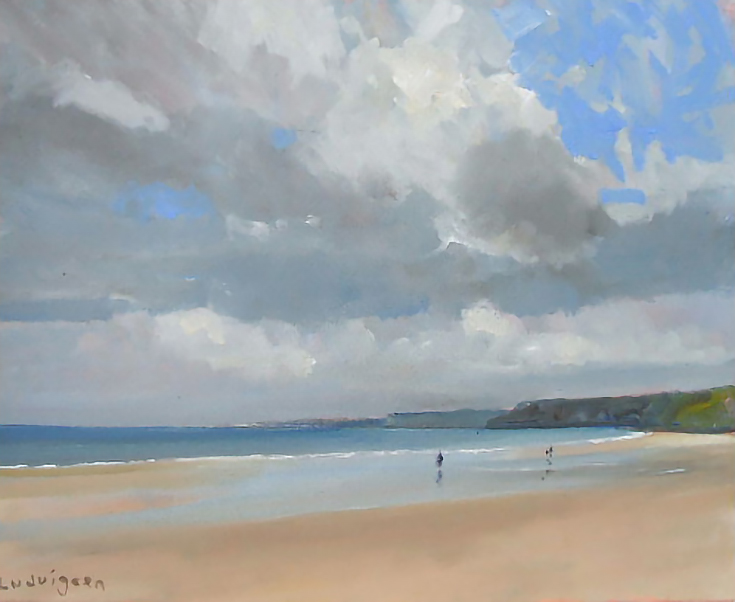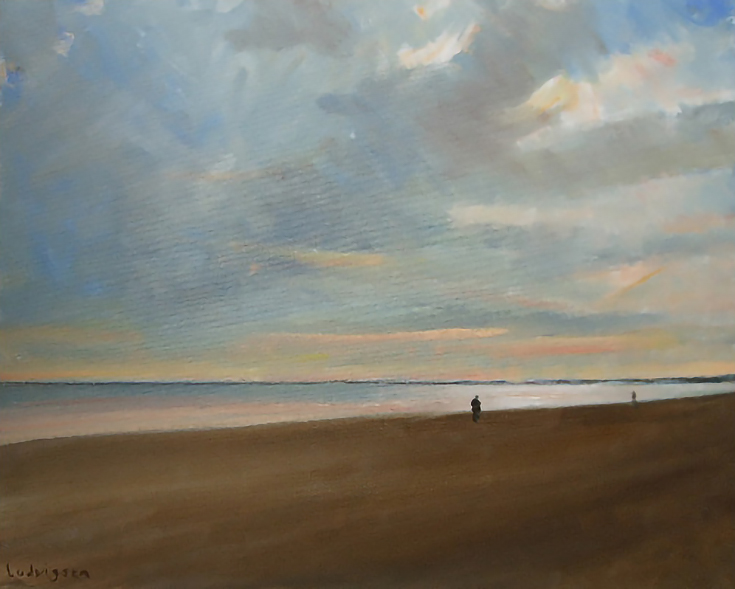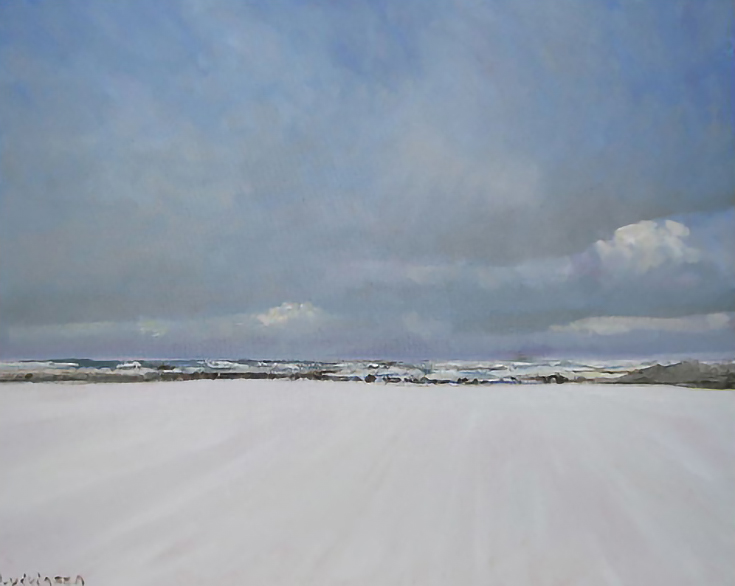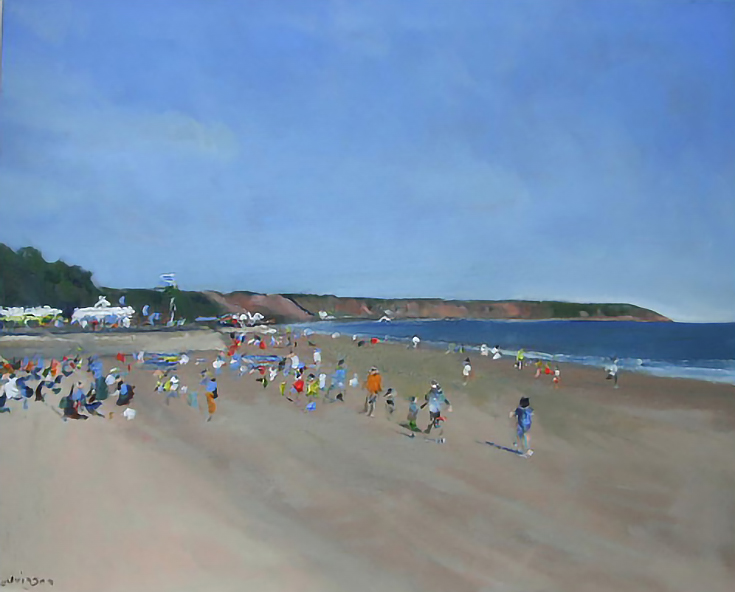Plein-air painting—or, painting outside in the open air with all the perils and dangers that entails—is a very odd, and perhaps silly thing to do.
Why not stay in your nice cozy studio with the central heating on, away from the vagaries of weather, biting insects, nosy people, gusts of wind blowing your canvas away, constantly changing light, and rapidly incoming tides?
Why not, indeed! And in fact most artists do, but a select few go out and brave the elements and even manage to paint a good picture as a result.
Somebody—I think it was one of the Scottish colourists—claimed that the more uncomfortable the conditions, the better the painting. This may seem a little extreme, but today I shall attempt to persuade you that painting outside is a worthwhile and enjoyable pursuit and can occasionally result is good paintings and good art.
First, a little background:
I am an oil-painter with a particular interest in this strange brand of painting. Whenever possible I like to paint in the open air, directly in front of the subject. This, I think, gives my work a vibrancy and vitality sadly lacking in much of studio painting. In fact, I disapprove of studios.
I’ve heard it said that a brush stroke in the field is worth twenty in the studio, and from my own experience I can heartily agree with this. But painting outside comes with a high price!
A few weeks ago I went painting on Filey beach with a friend of mine, an experienced studio painter, who thought it would be rather nice to try painting outside, especially at the seaside. She had acquired all the “recommended” equipment including a special pochade easel with neat little drawers for the paints and slots for the canvasses—but it weighed a ton! She was already complaining when we reached our painting spot a mile along the beach.
Then, of course, curious onlookers started to arrive and began to make comments and “helpful” suggestions about our paintings. The final straw was when a gust of wind blew her new pochade easel over and her canvas landed, wet-side down in the sand.
That was the end of her plein-air ambitions. She stormed off through the crowds of people who had gathered round to view the spectacle and hasn’t ventured outside her studio since.
Apparently, everything she’d read about plein-air painting beforehand was impractical, too optimistic, or just plain wrong. And that’s what gave me the idea of writing a short article about painting outside, based on my own experiences, where I emphasize the things that can go wrong and how to avoid them, as well as some tips of my own.
Let’s start with the gear you’ll need.
Your equipment should be light, compact and convenient—cut out all frills. Don’t, for example, take a stool to sit on! It is only extra weight, and you can’t paint a good picture sitting down.
Sir Alfred East RA, the celebrated Edwardian landscape painter and notorious snob, once said that no noble picture has ever been painted by a man sitting down. (And he said many other wise things, as we shall see later.)
Here’s a quick snapshot of my gear.
You can see the leg of my light-weight, telescopic easel (which is essential). You’ll also want to take along a tent peg for landscape anchoring and a plastic bag for beach anchoring. Why a plastic bag? Well, for years I found it difficult to anchor my easel on a sandy beach. Tent pegs (which work in hard ground) aren’t much use because they come out of the sand in the slightest wind.
The solution I eventually came across was to use sand itself! Simply fill a plastic bag with sand and drape it over the easel. Simple, obvious, and it works! An essential bit of my painting equipment is now a sturdy plastic bag.
Avoid wooden easels, especially fancy ones with neat little drawers and slots for canvasses. These are just too heavy to carry very far, and you usually have to walk a long way to find the best painting spot.
Here I am with my rucksack containing paints, brushes, easel etc. Palette and panels for painting on are tucked into the canvasses.
Canvas separators are essential if you want to get your wet canvases home safely. A tide table is also a good thing to have if you’re painting at the beach. And a good selection of brushes of course, and some fast drying medium, such as alkyd. I also use fast drying, alkyd white.
Everyone has their favourite palette. Mine is sky blue (Lukas studios), alkyd white, yellow ochre, burnt sienna, lemon yellow, ultramarine, and cadmium red.
By the way, earth colours like yellow ochre and burnt sienna may appear dull and lifeless, but when mixed with white have a particular luminescence lacking in the more gaudy cadmiums. They are particularly useful for clouds.
I find it best to carry my paints in a plastic box, a tupperware kind of thing. Two jam jars are also essential, one containing white spirit (thinner) and one containing a mixture of white spirit and alkyd.
(When I paint on the beach, I like to stick my brushes in the sand like arrows so they are easy to grab when needed.)
So what are the perils of painting outside?
At the most basic level, there may not be a handy toilet somewhere. This is not so important in the countryside with plenty of hedgerows and bushes, but it can be critical on a crowded beach.
The most common peril, however, and one which all outside painters dread, is people. Those determined footsteps coming up behind you and a voice saying “I see you’re painting, I hope you won’t mind if I watch. . .” send shivers up any painter’s spine.
What’s worse, many people expect you to have a conversation with them because they think painting is such a relaxing thing to do and requires no concentration.
This is, of course, completely untrue.
Mark Twain once said that painting is the most exhausting work one can do—personally, I think it is harder than shoveling coal—but most people who don’t do it think it is nice and relaxing.
If people are trouble, also beware of dogs! They don’t talk as much as their owners but can be just as much bother. If you have a wet canvas on the ground, you can guarantee the dog will walk on it, and, even worse, I’ve discovered that the smell of oil paint gives a dog the urge to urinate—so watch your painting bag!
Cows are lovely and great to paint, but they are very curious. If you find them arranged in some beautiful composition, don’t expect them to say there very long. As soon as you start painting, they’ll get up and walk behind you to see what you are up to.
Once, one of them even started to eat my paint brushes. . .
For this painting, they stayed there just long enough for me to sketch them in and then came over to see what I was doing.
Children, on the other hand, aren’t bad if you can cope with them, and they can be very funny.
When I was painting on the beach once, a little boy came up to me and asked if I was going to paint the crabs. The trouble is, one child tends to attract another and then another and you can end up being more popular than the Punch and Judy man.
All children seem to be terribly interested in painting—such a pity that they eventually lose it—and they make a much better audience than adults.
No matter what you’re painting, flies will either bite you or stick to your wet canvas—or both! Best leave them there till you get home and then remove them with the point of a palette knife.
Sand gets everywhere when you paint on the beach, particularly on wet canvasses. Don’t try to remove it immediately or you’ll ruin the painting. Also, don’t wait too long or you won’t be able to remove it at all and you’ll have a canvas like sand paper.
Best wait a day or two and scrape it off carefully with a palette knife. You can also just pretend it is texture.
Tides come in and out, so don’t get too absorbed in painting when it’s coming in. Check your tide table, and note whether the tide is coming in or going out. Start your painting accordingly, anticipating how things will look in an hour or two.
When I started this picture there was nothing but beach and by the time I finished it there was nothing but sea and my feet were wet.
Strong wind can be a real problem, especially gusty wind. I always anchor my easel and canvas very firmly but, even so, I’ve had canvasses blown away. Always note direction of the wind and try to paint the clouds accordingly, not as they are now but as they will be in a few minutes when you’re adding the final details.
The direction of the sun is very important. If it’s directly behind you, your canvas will be too bright and you’ll see your own shadow on it. If the sun is directly in front of you, it may be too dazzling to paint and the light will shine through your canvas.
I did this picture facing the sun. I avoided the problem of light shining through the canvas by putting two canvasses together using canvas separators.
Forgetting things is always a peril of outdoor painting as well. There’s nothing more annoying than getting everything set up and then fining that you’ve left an essential bit of equipment at home.
The best way of avoiding this is to have a well organized kit with everything in its right place so that it’s obvious if anything is missing.
It is, however, inevitable that you’ll forget something at some time or another. Our friend, the Edwardian landscape painter, Sir Alfred East RA, has some good advice in such an event. If, for example, you’ve left your brushes at home, he suggests that you simply hail a passing rustic and instruct him to run along and collect them for you.
Unfortunately, in the 21st century this doesn’t always work and may lead to verbal abuse.
But it’s usually possible to make do in one way or another. If you forget your palette, use a bit or cardboard or old wood. No white spirit? The village shop might have some. Forgotten your easel? Use a fence post.
Now, what are the pleasures of plein-air painting?
First off, it it simply more fun battling against the elements. And it can even lead to a better painting!
Experiencing the elements helps in painting them. Personally, I find it difficult painting through a window. Many painters take a photo which they use back in the studio to produce a painting.
There is nothing morally wrong painting from a photograph, and it doesn’t necessarily make you a bad person, but it can lead to a bad and boring painting.
Photos are always a disappointing representation of the real thing, so a painting based entirely on a photo can’t be much better. If you must use a camera, do a sketch as well. This might not be much good, but it will help put the image in your head and will help with the painting.
Paintings done outside, on the whole, are more lively and vibrant and the colour more true and brilliant.
I think one of the many reasons for this is that you don’t have time to be fussy or finicky; you simply can’t spend ages mixing colours and getting things just so (especially if the tide is coming in and the clouds are rapidly changing).
This leads to spontaneity which in painting can be much better than slow deliberation. Your figures might not have two legs and two arms, but they’ll certainly have more life than if you painted them in from a photo.
As this next painting demonstrates, it is perfectly possible to paint outside, even in winter, but you have to work quickly to avoid hypothermia.
I did this one very quickly to avoid an oncoming snow storm. No time for finicky details!
Of course the purpose of painting, apart from pure enjoyment, is to produce an interesting image, in other words, an interesting arrangement of colours and shapes. In this way, representational art is no different from purely abstract art.
The plein-air painter sees his interesting pattern “out there” before putting in on the canvas, while the non-representational painter must find his pattern in his imagination.
I don’t know about you, but the patterns presented to me by nature “out there” are much more interesting than the more pedestrian ones in my head. Whether it’s people, or cows, or waves. . . painting from nature always helps one to see deeper, and to see more.
To see more of Malcolm’s plein air paintings, please visit malcolmludvigsen.org.uk.
This post may contain affiliate links.
